电子信息类专业英语(西电第二版)Unit 17 Images and Televisions
第17章电子信息类专业英语(李白萍)
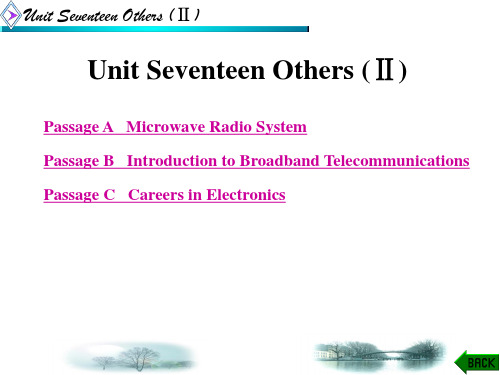
Unit Seventeen Others (Ⅱ)
On the other hand, in Europe, which consists of many small or medium countries, microwave systems in the network seems to be slightly less important. In many developing countries, microwave radio-relay systems play the key role in the network. It is quite logical because the microwave system has the following features: the initial investment required for the construction of transmission routes is low; the construction can be completed within a relatively short period; it is suitable for television transmission.
Unit Seventeen Others (Ⅱ)
Radio communication operating at medium or high frequencies was first applied to the fieldtime mobile and intercontinental communication, where its superiority was evident. It was only after the advent of microwave communication technology that it became possible for radio technology to be applied in full scale in the field where cable transmission had been dominant. Thus, the microwave radio-relay system using analogue modulation grew into a very important transmission medium in the overall telecommunications networks in many countries. Recently, a rapid advance in semiconductor and pulse circuit technologies gave impetus to the research and development of digital radio-relay systems.[2] There is now a marked trend that the telecommunication network is moving gradually towards digital systems.
电子信息工程专业英语 课文翻译 Unit 17 译文

Unit 17 计算机和网络Unit 17-1第一部分:计算机的进展计算机和信息技术的进展计算机和信息技术的诞生可以追溯到许多世纪以前。
数学的发展引起了计算工具的发展。
据说17世纪法国的Blaise Pascal构建了第一台计算机。
在19世纪,常被推崇为计算之父的英国人Charles Babbage设计了第一台“分析机”。
该机器有一个机械的计算“工厂”,类似于19世纪早期的提花织布机,采用穿孔卡片来存储数字和处理要求。
Ada Lovelace和他(Charles Babbage)致力于设计并提出了指令序列的概念——程序。
到1871年Babbage逝世,这台机器还没有完成。
将近一个世纪以后,随着电子机械计算机的发展(程序)这一概念再次出现。
1890年,Herman Hollerith采用穿孔卡片帮助美国人口普查局分类信息。
与此同时,电报电话的发明为通信和真空管的发展奠定了基础。
这一电子器件能够用于存储二进制形式的信息,即开或关,1或0。
第一台数字电子计算机ENIAC(电子计数积分计算机,见图17.1)是为美国军队开发的,并于1946年完成。
普林斯顿的数学教授V on Neumann对(程序)这一概念作了进一步深入的研究,加入了存储计算机程序的思想。
这就是存储在计算机内存中的指令序列,计算机执行这些指令完成程序控制的任务。
图17.1 ENIAC:第一台数字化电子计算机从这一阶段开始,计算机和计算机编程技术迅速发展。
从真空管发展到晶体管,大大减小了机器(计算机)的尺寸和成本,并提高了可靠性。
接着,集成电路技术的出现又减小了计算机的尺寸(和成本)。
20世纪60年代,典型的计算机是基于晶体管的机器,价值50万美金,并需要一个大空调房和一名现场工程师。
现在相同性能的计算机只要2000做芯片的单个集成电路来实现。
微处理器和微型计算机的发展微型计算机随着集成电路(或芯片)技术的发展而发展。
这一技术使得计算机逻辑被“烧入”芯片层中。
电子信息类专业课中英文对照表

电子系统设计
Electronics System Design
电磁兼容理论ElectromaneticCompatibilityTheory
电子设计自动化
ElectronicsDesign Automation
检测与转换技术
Signal Detection and Conversion Technology
计算机网络
Computer Networks
电磁场与微波技术
Electromagnetic Fieldand MicrowaveTechnology
现代通信技术
Modern CommunicationsTechnology
DSP原理及应用
Principlesand Applicationsof DSP
现代通信网
Modern Communication Networks
计算机网络安全
Computer NetworksSecurity
光纤通信技术(双语)
Optical Fiber CommunicationTechnology
实践环节翻译
实践环节翻译
军训及新生入学教育
MilitarySkillsTraining andFreshmenEducation
现代信息处理技术
Modern Information ProcessingTechnology
语音信号处理
Speech SignalProcessing
虚拟仪器基础(双语)
FundamentalsofVirtual Instrument
Matlab语言及应用
Matlab Language and Application
电子信息工程专业课程翻译中英文对照表
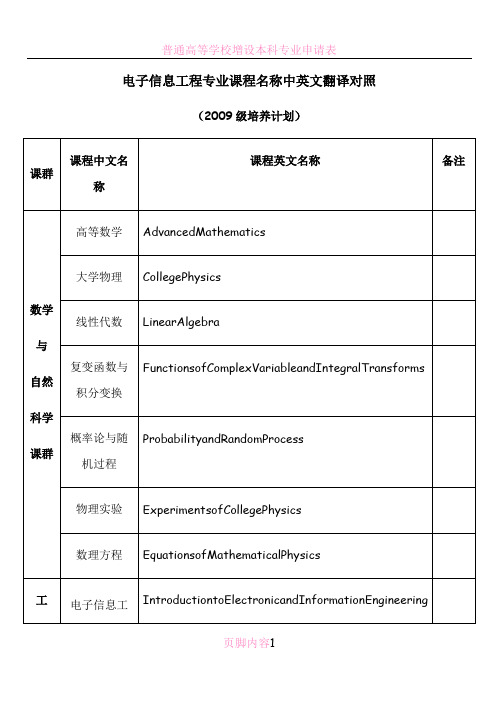
(2009级培养计划)
课群
课程中文名称
课程英文名称
备注
数学
与
自然
科学
课群
高等数学
AdvancedMathematics
大学物理
CollegePhysics
线性代数
LinearAlgeቤተ መጻሕፍቲ ባይዱra
复变函数与积分变换
FunctionsofComplexVariableandIntegralTransforms
光纤通信技术(双语)
OpticalFiberCommunicationTechnology
实践环节翻译
实践环节翻译
军训及新生入学教育
MilitarySkillsTrainingandFreshmenEducation
模拟电子技术课程设计
CoursePracticeforAnalogElectronic
信息论基础
FundamentalsofInformationTheory
信号与线性系统
SignalsandLinearSystems
微机原理与接口技术
MicrocomputerPrinciplesandInterfaceTechnology
人
文
社
会
科
学
课
群
马克思主义基本原理
FundamentalsofMarxism
生产实习
ProductivePractice
毕业设计(论文)
GraduationThesis
现代通信技术
ModernCommunicationsTechnology
DSP原理及应用
PrinciplesandApplicationsofDSP
电子信息工程专业英语教程__Contents
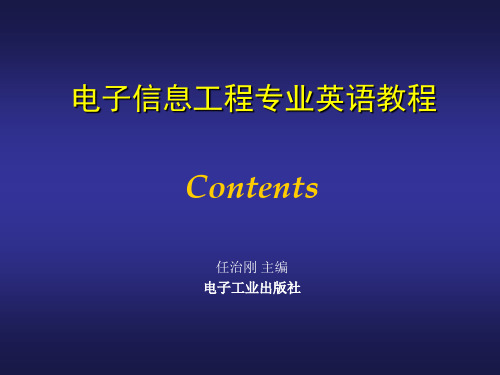
Usign
• Lesson 13 Overview of modern digital system design
• Lesson 14 Electronic design with FPGAs • Lesson 15 VHDL
Unit 6 Digital Signal Processing
• Lesson 25 Choosing the right core • Lesson 26 Design Languages for Embedded
Systems • Lesson 27 Choosing a Real-Time Operating
System
Unit 10 Electronic Instruments & Measurements
Unit 1 Electronic Devices
• Lesson 1 VLSI Technology • Lesson 2 Memory Devices • Lesson 3 Microprocessors
Unit 2 Electronic circuits
• Lesson 4 Operational Amplifiers • Lesson 5 Low-pass Filters • Lesson 6 Analog to Digital Converters
• Lesson 16 Basic Concepts of DSP • Lesson 17 Digital signal processors • Lesson 18 Comparison of DSP and ASP
Unit 7 Audio & Speech
• Lesson 19 High Fidelity Audio • Lesson 20 Audio Compression • Lesson 21 Third-Generation Mobile Phones:
电子信息类专业英语第二版 李白萍主编十七单元译文
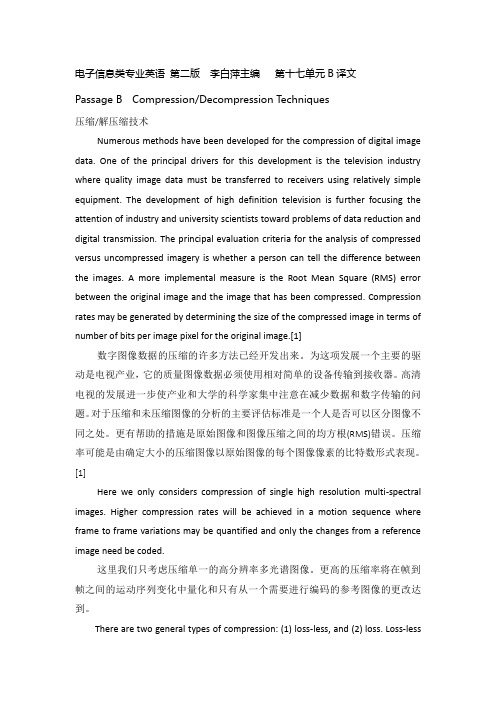
电子信息类专业英语第二版李白萍主编第十七单元B译文Passage B Compression/Decompression Techniques压缩/解压缩技术Numerous methods have been developed for the compression of digital image data. One of the principal drivers for this development is the television industry where quality image data must be transferred to receivers using relatively simple equipment. The development of high definition television is further focusing the attention of industry and university scientists toward problems of data reduction and digital transmission. The principal evaluation criteria for the analysis of compressed versus uncompressed imagery is whether a person can tell the difference between the images. A more implemental measure is the Root Mean Square (RMS) error between the original image and the image that has been compressed. Compression rates may be generated by determining the size of the compressed image in terms of number of bits per image pixel for the original image.[1]数字图像数据的压缩的许多方法已经开发出来。
电子信息技术专业英语

electro- 电electromagnetic wave 电磁波, electrodynamic 电动力(学)的
electrode 电极 anode 阳极、正极 cathode 阴极、负极 positive 阳性的、正的、正数 negative阴性的、负的、负数
2. 1 专业词汇 Speciality Vocabularies
Unit 5 Digital Logic Circuit (数字逻辑线路)
Unit 6 Electronic Instrument Introduction--Oscilloscope (电子仪器介绍---示波器)
Unit 7 Computer Basics (计算机基础) Unit 8 Computer Netwroks (计算机网络) Unit 9 A Manual of Setting Up Your PC (PC机安装 手册) Unit 10 Office 2000 Series (Office 2000 系列) Unit 11 Multimedia (多媒体) Unit 12 ISDN (integrated service digital network) (综 合业务数据网)
in the desired sequence 按希望的顺序
1 科技英语的特点 Features
1.1 长句 Long sentences A与B成(正/反)比例
e.g. For direct current and low-frequency (directly) alternating current (up to a few thousand A be (reversely) proportional to B cycles per second) the resistance is reversely proportional to the cross-sectional (inversely ) area of the path the current must travel; that (direct) is , given two conductors of the same A be in (reverse) proportion/ratio to B material and having same length , but (inverse) differing in crossing-sectional area , the one resistance is reversely proportional (reciprocal) with larger area will have the lower to area, that is, resistance. ratio of 3 to 7. 它们之间比率为3比7。 They are in a
通信与电子信息科技英语课件unit17

18 WAP(Wireless Application Protocol)
19 LSFR(Linear Shift Feedback Register)
20 portable device
21 digital cash
22 smart card
23 data stream
24 take account of
Security of Mobile and Wireless Network
12 repudiation
n .否认,抛弃,批判
nonrepudiation
n .认可
13 afterwards
adv .
14 commerce
n.
ecommerce (Ecommerce,electronic commerce)
Exercises
Ⅰ. Please translate the following words and
phrases into Chinese.
1. network resource
网络资源
2. trap door 3. Cipher Key (CK) 4. smart card 5. network controller 6. WAP 7. data stream 8. connection oriented 9. protocol stack
n.
n.
n.
v.
n.
n .互用性,互操作性
v .转移,跳变,跳跃
v .加密,译成密码
n .内联网,企业内部互联网
adj .必须的,义务的,强制性的
n .密码
n.Internet防火墙
Security of Mobile and Wireless Network
电子信息类专业英语(第二版)(李白萍)
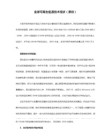
On the contrary,TS-SCDMA adapts the uplink/downlink radio according ro the data load within a single unpaired frequency thus utilizing the spectrum more efficiently,and provides dara rates ranging form 12kbps to 2Mbps.
6.作为一种以同步模式运行的结合CDMA自适应技术的高级TDMA、TDD系统,TD-SCDMA具有对称电路交换服务业务(如语音和视频)和非对称组交换服务业务(如手机上网)。
Designed as an advanced TDMA,TDD system with an adaptive CDMA component operating in synchronous mode,TD-SCDMA masters both symmetric circuits switched services (such as speech or video)as well as asymmetric packet switched services(such mobile internet access).
The signal-processing block at the transmitter conditions the source for more efficient transmission.
5.此外信号处理器还可以给数码子加入奇偶校验位,即提供信道编码 ,使的接收机的信号处理器可以进行误码检测和纠错,以减少或消除由信道噪声所引起的误码。
电子信息类专业英语Unit 17 Communication System
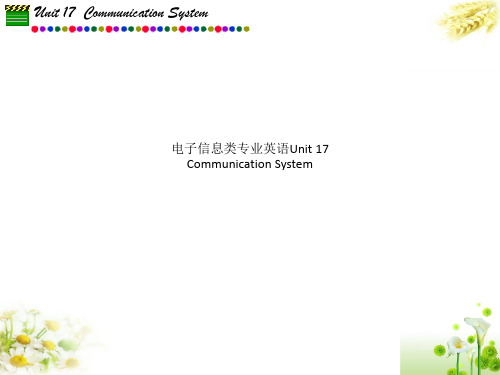
Unit 17 Communication System Fig.17-1 a Communication System
Unit 17 Communication System
The modulator produces a varying signal at its output which is proportional in some way to the signal appearing across its terminals. For example, a sinusoidal modulator may vary the amplitude, frequency, or phase of a sinusoidal in direct proportion to the voltage input. The roles of the encoder and the modulator are similar in that both prepare the signal for more efficient transmission. However, the process of coding is designed to optimize the error-free detection that a given message is being sent, whereas the process of modulation is designed to impress the information signal onto the waveform to be transmitted. The demodulator performs the inverse operation of the modulator is often referred to as a“modem”in data transmission.
电子信息专业英语(第二版)课件:Telecommunications

The golden age of automatic telephony occurred after World WarⅡwhen the entire long-distance network was automated. The invention of the transistor spurred the application of electronics to switching systems and led to the deployment of the first electronic switching in the late 1950s. Electronic switching made it possible to design and build switches with greater capacity.
Satellite communication was first proposed in 1945 by the British science fiction writer, Arthur C. Clarke. Satellite communications became a reality with the launching of the Russian satellite Sputnik (in 1957) and the American satellite Explorer (in 1958). The AT&T Telstar was the first experimental satellite capable of relaying television (TV) programs across the Atlantic Ocean. It was launched from Cape Canaveral(now Cape Kennedy)on July 1962. The first global civil communications satellite, INTELSAT Ⅰ(Early Bird), was launched in April 1965.
电子信息类专业英语翻译

1.This electron beam sweeps across each line at a uniform rate,then flies back to scan another line directly below the previous one and so on,until the horizontal lines into which it is desired to break or split the picture have been scanned in the desired sequence.电子束以均匀的速率扫描每一行,然后飞速返回去扫描下一行,直到把被扫描的图像按所希望的顺序分割成行。
2.The technical possibilities could well exist,therefore,of nation-wide integrated transmission network of high capacity,controlled by computers,interconnected globally by satellite and submarine cable,providing speedy and reliable communications throughout the word因此,在技术上完全可能实现全国性的集成发送网络。
这种网络容量大,由计算机控制,并能通过卫星和海底电缆实现全球互联,提供世界范围的高速、可靠的通信。
3.Transit time is the primary factor which limits the ability of a transistor to operate at high frequency.渡越时间是限制晶体管高频工作能力的主要因素4.The intensity of sound is inversely proportional to the square of the distance measured from the source of the sound.声强与到声源的距离的平方成反比。
电子信息类专业英语(西电第二版)Unit 7 Digital Modulation-精选文档
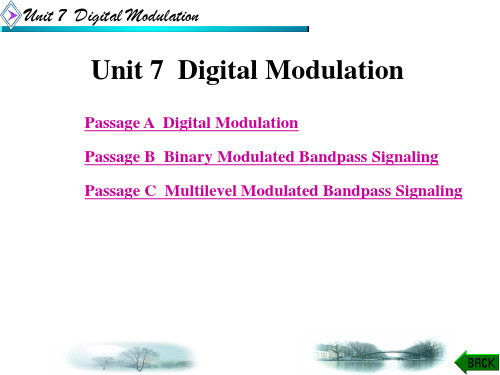
Unit 7 Digital Modulation
Passage A Digital Modulation Passage B Binary Modulated Bandpass Signaling
Passage C Multilevel Modulated Bandpass Signaling
Unit 7 Digital Modulation
In digital communication systems, the modulating signal (e. g., message) may be represented as a time sequence of symbols bits/symbol.[1] or pulses, where each symbol has m finite states. Each symbol repn, where n=log2m Many digital modulation schemes are used in modern
Unit 7 Digital Modulation
New multipurpose programmable digital signal processors have
made it possible to implement digital modulators and
demodulators completely in software. Instead of having a particular modern design permanently frozen as hardware, embedded software implementations now allow alterations and improvements without having to redesign or replace the modem.
第7章电子信息类专业英语(李白萍)
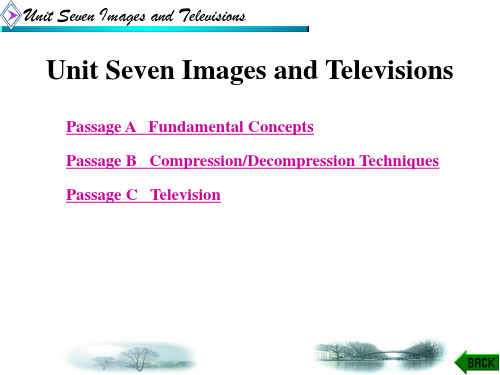
Unit Seven Images and Televisions Passage A Fundamental Concepts
Computational image processing can be defined as the operation of mathematical functions on numeric representations of pictorial scenes. In general it is part of an overall process of visual perception, pattern recognition and image understanding. These form the essential components of computer vision. Fortunately image processing is conceptually rather simpler than many of the cognitive processes associated with computer vision and has been the subject of rather more practical and successful effort. Whilst it may be of scientific interest to exploit mathematics in the pursuit of perception, the objective basis of image processing is to apply an algorithm to a representation (usually digital) of a visual scene to produce following results.[1] · Understanding through quantitation. · Perception through an improvement in a chosen index of quality. · Efficiency through improved image coding.
专业英语(电子与信息工程类)翻译

专业英语(电子与信息工程类)翻译1.As data networks advanced…also grew more complex.由于数据网络从面向终端的系统向分组交换、计算机与计算机连接的方向发展,执行网络功能所必需的协议也变得愈来愈复杂。
2.An additional bit called a parity bit…during transmission.在每个字符的后面有时还包括一个称为奇偶校验位的附加位,它们测试数据位在传输过程中是否被意外改变。
3.As already stated,with…downlink(FDD paired bands).如前所述,在非对称通信量应用中,TD-SCDMA利用可用频谱的效率比其他3G 标准高,因为它在只利用一个频带(TDD单一频带)而不是两个独立的频带(FDD成对频带)进行上行及下行通信。
4.Although often simpler to implement,…digital modulation.虽然光纤系统的模拟调制易于实现,但其效率较低,且要求在接收端有比数字调制高得多的信噪比。
5.At present,the bandwidth…electronics ()is possible.目前传输100km的几吉赫兹的调制信号和传输300km的几百兆赫兹的调制信号都是可能的,因此光纤系统的可用带宽并没有得到充分利用。
6.Both TD-SCDMA deployments-TSD…unpaired bands awarded.TD-SCDMA的两种部署——TSM和TDDCLR的数据速率、频谱利用率、覆盖率、移动性和可靠性等性能是一样的,并基本上为所有取得非成对TDD频段牌照的运营商所采用。
7.Crossbar switching was carried…selection for all calls.纵横制交换由一个称为标志器的特定电路控制,标志器提供整个号码的公共控制并选择所有呼叫的路由。
电子信息类专业英语(第二版) 课件李白萍
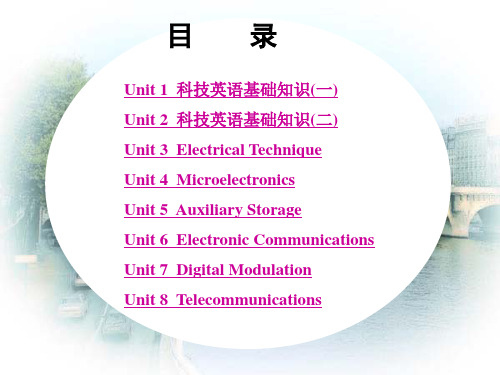
Unit 1 科技英语基础知识(一)
数词: naught,one,two,ten,twenty-eight,hundred, thousand,million,billion,trillion,first,second,third, one half,two third,a quarter,seven percent 连接词: and,as,as if,as well as,both ... and,either ... or,but,not only ... but also,for,if,even if,or,yet, while 名词: energy,form,material,line,process,time, result,unit,value,area,field,method,effect,distance, limit,period,direction 代词: other,such,that,this,their,these,which,it, its,itself 这些词汇在科技英语中的意义和用法与在普通英语中基 本上是一致的,因此读者一般不会有多大困难。
Unit 1 科技英语基础知识(一)
冠词: a(或an),the 动词: be,do,take,have,get,give,find,form, increase,obtain,show,work,operate, perform,carry, account 副词: all,more,ago,already,before,finally, immediately,nearly,usually,never,frequently,actually, so,slowly 形容词: all,great,high,large,more,small,good, big,round,square,hard,little, simple,complex,basic, common,internal,external,usual 介词: about,above,after,among,at,behind,beside, between,beyond,by,except, for,from,in,into,of,off, on,over,up,upon,to,by means of,toward
电子信息类专业英语(西电第二版)Unit 18 Multimedia_OK
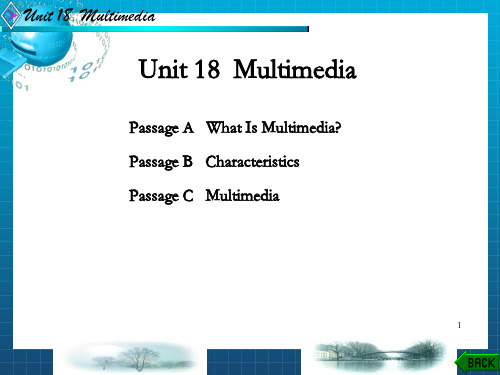
Unit 18 Multimedia
workstations designers, and database researchers view multimedia from different perspectives. One point where they agree, however, is on the essential role played by multimedia data.[1] For instance, multimedia presentations, as their name suggests, involve the presentation of multimedia data, multimedia workstations deal with the processing of multimedia data, and multimedia databases with its storage and retrieval. Perhaps, then, the notion of multimedia data is a unifying thread to digital multimedia.
Unit 18 Multimedia
Unit 18 Multimedia
Passage A What Is Multimedia? Passage B Characteristics Passage C Multimedia
1
Unit 18 Multimedia Passage A What Is Multimedia?
8
Unit 18 Multimedia
NOTES [1] One point where they can agree, however, is on the
- 1、下载文档前请自行甄别文档内容的完整性,平台不提供额外的编辑、内容补充、找答案等附加服务。
- 2、"仅部分预览"的文档,不可在线预览部分如存在完整性等问题,可反馈申请退款(可完整预览的文档不适用该条件!)。
- 3、如文档侵犯您的权益,请联系客服反馈,我们会尽快为您处理(人工客服工作时间:9:00-18:30)。
电子信息类专业英语(西电第二版) Unit 17 Images and Televisions
Unit 17 Images and Televisions
Passage A Digital Image Fundamentals
1. Digital Image Resolution A digital image is made up of many rows and columns of pixels. For gray scale images, each pixel is assigned a number that represents the gray shade assigned to that pixel. The larger the number of pixels in an image, and the larger the number of available gray scale levels, the better the resolution of the image. Figure 17.1 is an 17-bit images, with 217=256 possible gray scale levels. The number of row and column are 303×228.
Unit 17 Images and Televisions
When two images are added or subtracted, the resultant matrix will frequently contain illegal gray scale values. For example, when a pixel in one 17-bit image has the gray scale level 129 and the corresponding pixel in a second 17-bit image has the gray scale level 201, the sum pixel is 129+201=330. This is outside the legal range for an 17-bit image, which may only contain gray scale levels between 0 and 255. When the same two images are subtracted, the difference pixel is 129-201= -72, again a value outside the legal range. For these reasons, scaling follows most image arithmetic. Scaling to the range [0, GSLmax] may be accomplished as follows:
ScO alu etd n p ]u M Q t(O [u am tx u n p )- ,M ] tM up(t( O O u [iin m n tu u ))G t,tp p m S u u aL nd Televisions
Figure 17.2 A Histogram
Unit 17 Images and Televisions
3. Addition and Subtraction of Images Digital images can be added and subtracted pixel-by-pixel. Adding two images can combine two sets of objects into a single image. Moreover, several noisy images of the same scene can be averaged together to reduce the effect of noise. Image subtraction, on the other hand, can be used to remove an unwanted background from an image. Subtraction of two timelapsed photographs will show where motion has occurred between the two.
Unit 17 Images and Televisions
Figure 17.1 An 303×228×17 Digital Image
Unit 17 Images and Televisions
2. Histograms The gray scales present in a digital image can be summarized by its histogram (see Figure 17.2).The histogram reports the number of pixels for each grayscale level present in the image, as a bar graph. When an image uses only a small portion of the available gray scale levels, histogram equalization can be used to spread out the usage of gray scale levels over the entire available range[1].This procedure re-assigns gray scale levels so that image contrast is improved.
